STRANGEBUTTRUE- Sleepwaking: Lucid dreams are secondary consciousness

DRAWING BY DEBORAH DERR McCLINTOCK
Q. How might you be awake and asleep at the same time? –R. Norment
A. By waking up in your dreams, which is how researchers describe "lucid dreaming," where the dreamer becomes aware it's only a dream even as the dream unfolds, says New Scientist magazine.
It appears that lucid dreamers' brains are in a penumbral state between waking and sleeping, affording opportunities for the study of consciousness. Perhaps confronting our demons in lucid dreams could help us overcome phobias; further, practicing a motor task in a dream, such as dancing or playing an instrument, may hone skills for the waking world. The lucid dream amounts to a sort of secondary consciousness– not only aware of events but aware that we are aware– a quality thought to be unique to humans, says journalist Jessica Hamzelou.
Yet how can a researcher be sure someone is having a lucid dream? Ursula Voss at the University of Frankfurt in Germany trained a group of students to signal while asleep and dreaming, by moving their eyes in a pre-agreed pattern, measurable with an electro-oculograph.
"It takes a great effort to make these eye movements," explains Voss, "because normally in such a dream the person doesn't want to communicate with the outside world."
After weeks of reality checking– "Am I awake or asleep?"– Hamzelou herself one Easter weekend finally had her first lucid dream. "It lasted all of a few seconds, and I was merely able to consciously twirl on the spot, but I woke up excited and happy."
Q. How many digits of "pi" can you remember from high school math? Certainly nowhere near Akira Haraguchi's stunning achievement. –P. I. Thagoris
A. The retired Japanese engineer set a world record in 2006 by memorizing and reciting 100,000 digits of "pi," which expresses the ratio of a circle's circumference to its diameter, or 3.14159..., says Clifford Pickover in The Math Book.
Perhaps ancient peoples observed that for every revolution of a cartwheel, a cart moves forward about three times the diameter of the wheel. The famous symbol for pi probably stemmed from the first letter of the Greek word for "periphery." Pi's digits never end, nor has anyone detected an orderly pattern in their arrangement.
Interestingly, "the speed with which a computer can compute pi is a measure of its computational ability, and today we know more than a trillion digits of pi."
Q. Why are we humans such voluminous water sponges? –B. Mooney
A. It's not just drinking or bathing, says IEEE Spectrum magazine. Without water, we'd have practically no energy; and without energy, there would be no cars, planes, lighting, laptops, or smart phones.
Water cools the blistering steam of thermal plants and allows hydroelectric turbines to churn. It brings biofuel crops from the ground and geothermal energy from the depths of the Earth. Plug your flashy iPhone into the wall and about half a liter of water must flow through kilometers of pipes, pumps and the heat exchangers of a power plant. That's a lot of money and machinery for a 6-watt-hour charge.
In the U.S. alone on just an average day, more than 500 billion liters of fresh water move through the country's power plants— more than twice what flows through the Nile. Or as water blogger Robert Osborne calculates it, a single Google search takes about half a milliliter of water, meaning the 300 million daily searches take 150,000 liters, or a thousand bathtubs to power the data centers handling the world's idle curiosities.
"We challenge you to find an activity more trivial than a search engine query," says Osborne.
~
Send Strange questions to brothers Bill and Rich at [email protected]
#